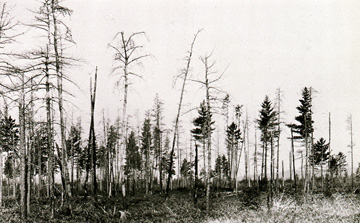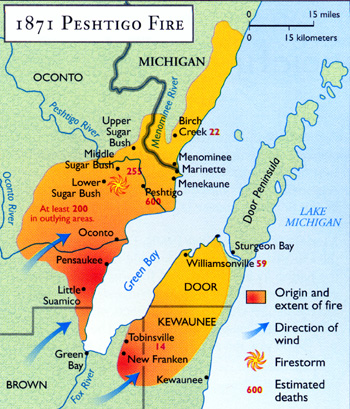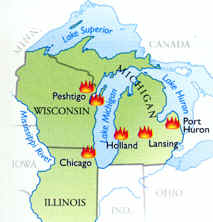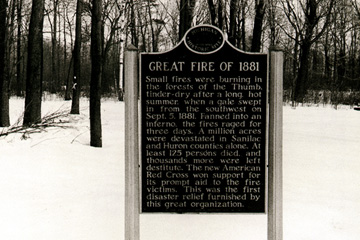Economic prosperity due to the logging industry in Michigan was breeding ecological disaster. Timber waste, forest fires, and a total lack of interest in conservation practices all contributed to the devastation. A great fire in 1871, for example, damaged the entire Lake Michigan shoreline, destroyed the cities of Holland and Manistee, and spread across to Port Huron. By 1900, the lands of the northern Lower Peninsula and the eastern Upper Peninsula were stripped of pine, and scores of lumber towns were dying.
Fire has played a major role in shaping vegetation patterns. Native Americans set fires to clear wooded areas and improve wildlife habitat for hunting. European settlers suppressed brush fires, causing forests to replace some large prairies. Wasteful timber-cutting practices led to disastrous forest fires, including the deadly 1871 Peshtigo fire. In the early lumbering days, more timber was lost to fire than was actually harvested. Today, wildfires still affect the logging, tourism, and recreational industries. Most fires strike between March and November; they occur particularly often in drought years.
Forest fires were a part of the logging scene in Michigan, although not necessarily the result of it. Nor were forest fires new to the state at the time logging began. Extensive burned-over areas were reported by early surveyors long before the lumbermen arrived. But the great influence of people during the logging era, and the large areas of dry pine slash increased both the possibility of fire and the intensity of those which occurred. Many reached tremendous proportions, burning unchecked for weeks or months through slashings, standing timber, cities and settlements, causing human misery, death, and waste. There is evidence to show that these lumbering era fires destroyed more merchantable timber than was cut. Most of the pine areas in the north part of the Lower Peninsula have burned over at least once, and many several times. Fires were not confined to pine lands, for hardwood slashings also burned. Large parts of these once charred lands are now occupied by jack pine, oak, aspen, and white birch, species which form much of the young forest growth found in northern Michigan.
Forest fires have posed a danger throughout Michigan history, particularly in times of drought. The wasteful practices of the early timber industry worsened the hazard by leaving behind huge amounts of dry wood and brush piles.
After decades of logging activities, Michigan was littered with thousands of hectares of slash--dead branches, leaves, and wood. In their haste to move on to new cutting sites, loggers usually gave little thought to the lands they were leaving. By the 1870s stumps and branches already littered much of northern Michigan. There was no longer any barrier to erosion on cutover land, and the dried debris created an enormous fire hazard. At the end of the dry summer months fires frequently broke out, sometimes moving into still uncut timberlands or settled areas, as in 1871 and 1881, when fires broke out across the state.
Upon drying, these became highly flammable, and led to innumerable fires. Many of
these fires were immense, covered large areas, and burned for days. The scene below
shows an area near the Upper Manistee River after an 1894 fire.

Source: Unknown

Source: Unknown
Michigan’s first catastrophic fire was in the autumn of 1871. However, the
hundreds of lives lost in fires in Chicago and northeastern Wisconsin at the same time
overshadowed Michigan’s losses. A combination of numerous small and large fires, the
1871 fire swept across the Lower Peninsula, destroying Holland, Manistee and several
Saginaw Valley towns and leaving an estimated 20 dead. A decade later, in September 1881,
the Thumb was ravaged by fires that took 282 lives, blackened a million acres and cost
$250,000 in property damage.
The 1871 fires
Let's start with the first big fires in the region--which also happen
to be the most famous and the largest! Inevitable disaster occurred in the drought
year of 1871. On the night of October 8, hot winds from the south caused normally
controllable small fires to shift suddenly and gather force. They swept through a 60-mile
stretch north of Green Bay, Wisconsin and a 50-mile stretch on the Door Peninsula, and
collectively became known as the "Peshtigo Fire." The conflagration claimed an
estimated 1,200-1,500 lives. Survivors later told of jumping into rivers to escape the
flames, and witnessing firestorms, or "tornadoes of fire," that devastated
enormous areas. Many of those who sought shelter in the Peshtigo River literally
boiled to death.

Source: Atlas of Wisconsin
On October 8, 1871, at about the same hour, two devastating fires started, one in rural
Peshtigo, Wisconsin, the other in downtown Chicago. Both fires remain today among
the worst natural disasters to befall the Midwest. In fact, no forest fire since the
Peshtigo disaster has taken more lives; and the Chicago fire remains the most
destructive metropolitan blaze in the
nation's history, having caused some $200,000,000 in property damage and all but
obliterating the city's core.
The Great Chicago fire caused an estimated 250 deaths. Numerous fires on Michigan’s Lower Peninsula also started on October 8, 1871, at places like Holland, Lansing, and Port Huron (see map below). Because they started during the day, the Michigan fires claimed fewer lives, though they destroyed more land and timber. Newspapers of the time publicized the Chicago fire widely, making it the most infamous of the three disasters. The Peshtigo Fire stands today as the deadliest forest fire in modern world history.

Source: Unknown
The Holland fire, like the others, was due to a combination of high winds and extremely
dry conditions. The heart of the Dutch settlements in western Michigan (at Holland)
shared the same kind of disaster that struck Chicago, Illinois, October 8 and 9, 1871. At
the time, Holland was a small, insignificant town in comparison to Chicago, but for the
Dutch immigrants in Michigan, the "Colony at Holland" (pop. 2400), as it was
first known, was the focal point for religious refugees who had come in 1847.
A devastating economic tragedy, the fire of 1871 nearly wiped out the
town founded by the Rev. Albertus C. Van Raalte. The results of hard work of 24 years were
practically wiped out in the early morning hours of October 9. But it was also a disaster
for the concept and vision that brought the Dutch to western
Michigan. Although the basic concept was fading into the background when the tragedy
occurred, the ideas which brought the village into existence were still operative in the
functioning of the town. Fortunately the fire impeded the growth and development of De
Kolonie only temporarily.
Most of the townspeople were Dutch immigrants, but a mixture of native
Americans was evident by the fact that two lodges functioned in the town (to which Dutch
immigrants by religious conviction did not belong), and some English speaking
congregations, such as Methodist and Episcopal, had been organized. The Dutch were members
of either the predominant Dutch Reformed Church or the True Reformed Church which broke
from the Dutch Church in 1857. All in all, Holland was a very flourishing little city that
had a harbor and new rail connections, making it a natural market for all the outlying
agricultural districts.
A period of extensive drought preceded the fire of 1871. Several fires
had broken out around the town before October 8, and Hope College had been threatened only
a week before. An added hazard was the cut timber and brush that lay in the woods
surrounding the town. The old river bed and ravine along Thirteenth Street behind the
Third Reformed Church was filled with such debris. The situation became critical on Sunday
afternoon, October 8, when a southwesterly wind began to build up in intensity. The
townspeople turned out en masse to fight fires that were flaring up on the southern
and southwestern part of the town even though that first alarm sounded during the time of
the afternoon church services. Disaster was upon the town with the development of
"hurricane" winds in the evening. Any thought of saving the town was forgotten
when two major structures on the west side caught fire. Within the space of two hours the
fire took its toll. "The entire territory covered by the fire was mowed as clean as
with a reaper; there was not a fencepost or a sidewalk plank and hardly the stump of a
shade tree left to designate the old lines," said one resident.
Although the disaster was nearly total, the recovery was rapid, and
Holland today is a thriving city in its own right.
The 1881 Thumb fire:
The fire of 4-6 September 1881, commonly known as
the Thumb Fire, burned well over one million acres, cost 282 lives, and did more than
$2,347,000 damage. The fire destroyed a major part of Tuscola, Huron, Sanilac, and St.
Clair counties. It consumed 1,531 houses and 1,480 barns and outbuildings, and left
14,448 homeless. Like the 1871 fire, the fire of 1881 came at the end of an
extremely severe drought and was the result of hundreds of land-clearing fires whipped
into a cauldron of flame by high winds. In the Saginaw Valley and the Thumb region it
burned over much the same territory that had been burned by the 1871 fire. This fire, 10 years previous, had been so strong that winds associated with it had
blown over trees, and many of these were still laying around, dry. Also, 1871 fire
did not consume all the slash left by the logging operations of the previous decades, so
much was left to burn. No one is sure just how or just where in Tuscola County the
fire started. It was the time of year when people used to burn brush piles and other
debris left by lumbermen and those engaged in clearing the land. Many people think the
wind may have whipped a brushpile fire out of control. The fire probably started as
a series of small blazes in slash fires coalesced into a wall of flame moving to the NE.
Its severity is accounted for not only by the drought and high winds that
prevailed, but by the fact that the country was full of slash from logging and land
clearing, and of dead and down timber killed, but unconsumed, by the fire of 1871.
The appalling thing about this loss of life was the large number of children
involved due to whole families being wiped out. One detailed account of the fires
that burned in the Thumb is given in a report of a man who traveled over the burned area
after the fire and interviewed many of the survivors. He emphasizes the extreme dryness
that prevailed, the presence of vast areas of logging slash, the debris left by the fire
of 1871, the prevalence of land-clearing fires, and the occurrence of winds of hurricane
force, all of which combined to produce the holocaust which resulted. There have been bad
fires in Michigan since, but none as severe or extensive as the great fires of 1871 and
1881.

Source: Photograph by Randy Schaetzl, Professor of Geography - Michigan State University
Persons who have not experienced a big forest fire cannot conceive of the appalling
conditions which occur and the terror and helplessness of those in its path. The following
excerpts from contemporary accounts give some idea of the conditions that prevailed in the
1881 fire:
From the Evening News, Detroit: Thursday, September 1, 1881:
"The drought all over the Mississippi Valley and throughout the
northwest continues with unabated rigor. Atmosphere scorches and blisters
everything...vegetation dried to a cinder, gives nothing but material for fire. Trees
shedding their leaves a month before the usual time; grass brown and withered. Pastures
and streams dried up. Milk scarce, butter a luxury. If it does not rain and rain hard
soon, food will be scarce this winter...Buyers paying the unheard price of 18 and 20 cents
a pound for butter."
Saturday, September 3: "Farmer near Stark
overcome while fighting fire and burned to death."
Tuesday, September 6: "Women burned to death
while fleeing for shelter near Lapeer...terrible fires reported raging in the forests
northwest and north of Bay City...air full of cinders... people suffering from heat and
smoke...Fires devastating the woods around Flint."
"Saginaw: Intensely warm and smoke
suffocating. East of the city forest fires raging fiercely. ...hundreds of acres afire.
Fires plainly visible from the city at night...
"Detroit: Heat and drought almost
unprecedented. Throughout the timber regions great forest fires are raging in all
directions from the Mississippi to the ocean. In many places the earth is so dry that
fires have penetrated into the soil, following the vegetable fibers and moving
mysteriously by this means over many miles only to break to the surface in a destroying
conflagration wherever the surface vegetation furnishes fuel. (Fires) seem to break out
spontaneously from the bosom of the earth.
"Port Huron: Tremendous fires in Sanilac and
Huron counties...Richmondville destroyed and Deckerville reported burned... Many people
horribly burned."
Source: Unknown
Wednesday, September 7, 3:00 p.m.: "Wholesale
devastation in Saginaw Valley and Huron peninsula. Entire townships becoming roaring
furnaces and let in ashes.., Over 30 lives lost...survivors fleeing to the lake.
4:00 p.m.: "At least 100 lives lost in
Sanilac County alone. Men, women and children burned on the roadside while seeking
shelter.
Friday, September 9: "The worst ever:
Thirty-one townships and 11 villages swept by the flames...45 bodies found near Paris in
Sanilac County...fire started in NW part of Sanilac County and in adjoining Huron County
from settlers burning to clear land...spread east and north to the lake shore, then west
through Huron County, then south and southwest, then east across Cass River where it met
another part of the fire and raged for twelve hours...500 to 600 dead, 2,000 families
homeless, 15,000 destitute."
An intimate account of conditions is found in the story told by a
Reverend of the First Baptist Church of Harbor Beach, who said: "At sunrise, Monday, September 5, the air was clear. By 1:00 pm the sky was
copper colored. At 2:00 it was so dark that lanterns were necessary out of doors to find
one’s way around. Darkness continued all afternoon. Many thought the end of the world
was at hand. Terror heightened by the approach of flames, the stories of destruction to
the west, and the arrival of charred remains and refugees. This continued until Wednesday
morning, when at 8 am the wind changed to north and brought relief."
Said one, a resident of Minden City, speaking to a local reporter three
days after the flames subsided, "By six o’clock the people
began coming into Minden from the west, having barely escaped with their lives, and when
morning arrived hundreds had found their way here in a half-nude condition, burned and
blinded by the smoke. We then began to have a faint realization of the extent of the fire.
Then we first understood that not property alone, but human lives had been swallowed up.
To the west and north the roads were lined with the carcasses of horses, cattle, sheep,
swine and poultry, etc., cooked and charred almost to a crisp. Then human beings, also
cooked and charred, were found. Some were still alive, with the feet, hands and face
literally baked. Some had their ears and nose burned off, and their eyes almost burned out
of their sockets. It is too horrible to contemplate!"
Farmers along the Cass River fled to the water for safety as the fire
rolled over them, again and again. They saved their lives, nothing else. Cinders and ash
fell into the river. The water was so hot the fish died and floated on the surface by the
hundreds.
The fire appeared at Bad Axe, 20 miles northeast of Cass City, a little
after 1:30 p.m. Monday. The winds had begun at noon and, according to observers, trees
were broken off at the stump, boulders rolled along like pebbles, and people lifted off
their feet into the air. Above the wind, a strange roar was heard, the sound of the
approaching flames. Shortly after 1 pm there was darkness, as though a curtain had fallen.
Four hundred people fled to the new brick courthouse. As they watched,
building after building burned around them. Thirty men pumped water from the adjoining
well and kept the walls and tile roof wet. After a few minutes they had to return inside
because of the heat, and another 30 would take over. Across the street, barrels of
kerosene and gunpowder ignited when the hardware store burned. The store turned dark, then
blew into a bright, red glare.
Thirty townsfolk made it east to a plowed field on W.F. Thompson’s
farm, the fire gaining on them. They dug a ditch and covered it with boards and blankets.
While the women and children remained under cover, the men took turns keeping the blankets
wet.
"It grew so dark at Zinger’s Hotel at
12 noon," said William Bope, "that they were
obliged to light lamps." At about 1 p.m. the wind changed and blew at
hurricane force from the west. At the same time the fire started all over the large
clearing in small patches of blue flame. In every direction small fires could be seen
starting up. By 1:30 a solid wall of flame, from 50 to 100 feet high, was sweeping from
the west over Paris. At nearly every house, women and children were out in the road,
wailing and wringing their hands in despair. The smoke was so dense that nothing could be
distinguished 300 yards away. The fire seemed to burn everywhere at the same time, as
though it dropped from the clouds. The sky looked like one sheet of flame.
Hundreds found refuge in wells while the flames passed over. Others
survived by reaching an open field and burying their faces in the dirt to breathe. They
dug holes with their hands, lay face down in ditches or waded out into a river or the
lake. Survival was often a matter of chance. In Paris Township, where 23 bodies were found
the first night, the fire traveled 10 to 20 mph, the speed of a running man. "Horses
did gallop before it, but were overtaken and left roasting."
Many bodies were found untouched by the flames, killed by suffocation,
smoke inhalation and the heat. Some survivors died later of burns and inflammation of the
lungs. "The heat from the flames was so intense,"
Said William Bailey, stationed at Port Huron, "that sailors
felt it uncomfortably even though the hot air had moved over the cold water of Lake Huron
a distance of seven miles. It withered the leaves of trees two miles from its path. Whole
fields of corn, potatoes, onions and other growing vegetables that were not touched by the
flames, roasted by the heat."
Monday night the winds abated. Fires burned across the entire area from
Saginaw east to the lake where the walls of flame had passed, "lighting
up the heavens." Tuesday night the winds reversed and pushed the fires back
over the burned districts. Heavy rains late Wednesday put an end to most of the burning,
but the suffering and afflictions had only begun.
Flames leapt to treetops and raced along on strong winds. The fire
raced northeastward to the lake shore at the tip of the Thumb. Then winds shifted to the
west and the fire spread eastward through Sanilac and St. Clair counties.
Mr. Spencer recalls how farmers in the Deford area (at the boundary of
Tuscola and Sanilac counties) saw the fire coming and thought the end of the world was
upon them. He tells of how minutes before the fire reached his parents’ farm, and
while the wall of flame was more than a mile away, a large stump in the middle of a
cleared field suddenly burst into flames.
Wild animals took refuge in buildings with humans. Men put women and
children into wells. Some people escaped by wading into rivers and covering their heads
with wet blankets. Those who lived near the lakeshore took refuge in the waters of Saginaw
Bay and Lake Huron.
Mr. Spencer recalls that a neighbor’s team of oxen came through
the fire alive but lost their hooves; that another neighbor turned six hogs loose and
never found a hair of them...but did find six large grease spots several yards from where
he had released them.
The fire acted queerly, it seemed to those early Thumb residents.
Flames would engulf one building and suddenly extinguish themselves while destroying other
buildings nearby.
One neighbor was sure all would be lost in the fire. This man boarded
up all openings to his barn, then slit the throats of all his livestock and ended his own
life with a shotgun. He was found later, after fire passed by and left his buildings
untouched.
"To realize how these fires could be so destructive and
extensive one must understand the condition of most of the unimproved land in Huron
County. The fires of 1871, which were so general, converted a great portion of the green
woods into windfalls.
"All of the timber (consisting largely of pine, hemlock and cedar
with some hardwoods) on thousands and thousands of acres fell down and were piled and
interlocked in every shape in impenetrable masses. It has been a common remark that there
would yet be another fire greater than the one which caused these windfalls before they
could be gotten rid of. During these ten years something has been done towards cleaning
them up. Large quantities of cordwood and timber had been taken from them.
In spite of the horror and devastation brought to the inland portions
of the county, an optimistic item appeared in the Caseville locals-no doubt read with some
bitterness by those who suffered in the fire: "Although bringing misery to so
many, we can hardly realize at present the great benefit the country will derive from the
fires in the near future by rendering the land more available for settlement. Everything
will progress with rapid strides. Railways will be pushed through; a tide of immigration
will pour in; farming and pasturage will be largely engaged in and in ten years from now
the country will be 50 years ahead."
Click here to go to part II of this page on Michigan's post-logging fires.
Note: some of the text and images in this section have been paraphrased and taken from Betty Sodders' book, "Michigan on Fire", and from various issues of Michigan History magazine. Finally, parts of the text above have been paraphrased from C.M. Davis’ Readings in the Geography of Michigan (1964).
This material has been compiled for educational use only, and may not be reproduced without permission. One copy may be printed for personal use. Please contact Randall Schaetzl (soils@msu.edu) for more information or permissions.